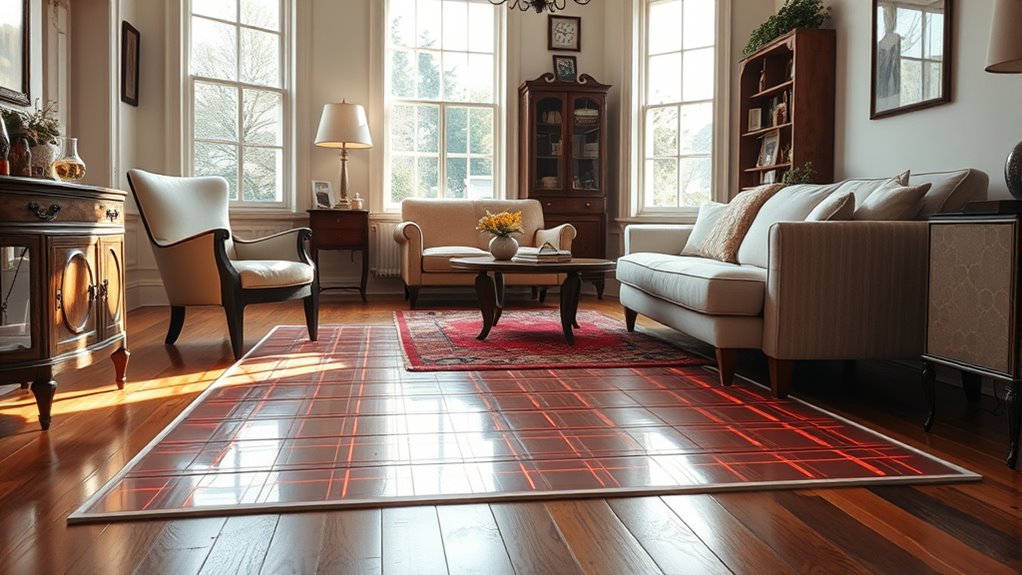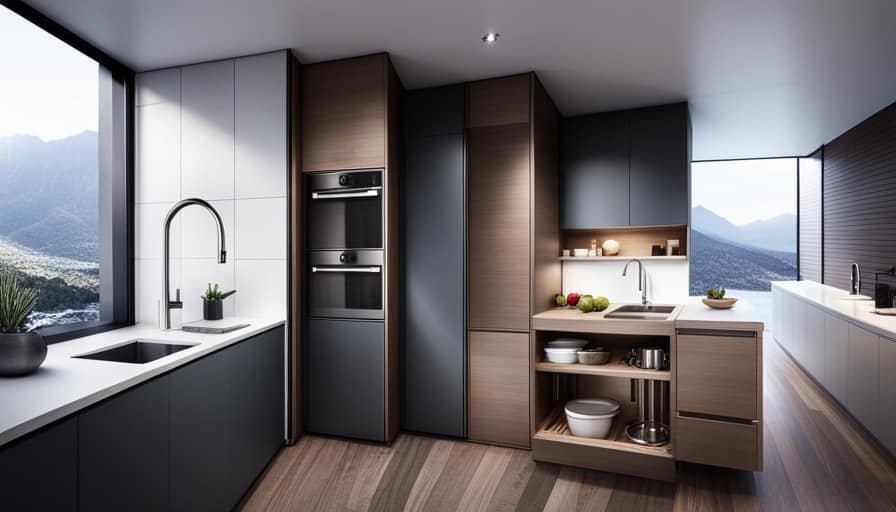Retrofitting radiant floor heating in your existing home can save you up to 30% on energy bills and improve comfort with even, quiet warmth. While installation may pose challenges like access, flooring removal, and material choice, the long-term savings and durability often outweigh initial costs—ranging from $12,000 to over $40,000. Electric systems heat quickly, ideal for small zones, while hydronic systems offer sustained efficiency. To explore the best options for your space, keep exploring further.
Key Takeaways
- Retrofitting can reduce energy consumption by approximately 5.9%, with a payback period around 10 years.
- Costs vary significantly: electric systems ($19,000–$36,000) and hydronic systems ($14,000–$48,000), depending on scope and materials.
- Proper insulation and flooring choices, like porcelain tiles, maximize heat transfer and long-term savings.
- Accessibility challenges and existing flooring removal can increase installation costs and project duration.
- Long-term benefits include increased comfort, reduced energy bills, and system lifespan over 30 years, enhancing home value.
Understanding the Benefits of Radiant Floor Heating
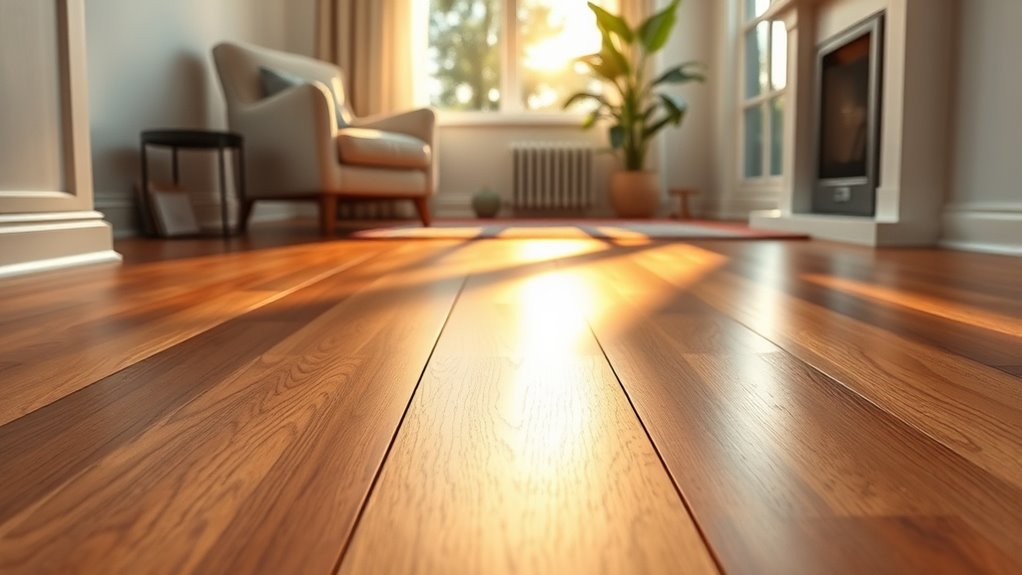
Radiant floor heating offers a range of compelling benefits that make it an attractive choice for modern homeowners. It can slash your energy use by up to 30%, saving you money and reducing your carbon footprint. Compared to forced-air systems, it’s 25-30% more efficient, mainly because it eliminates heat loss through ductwork. You’ll enjoy even, consistent warmth that keeps your home comfortable and helps with allergy relief by not circulating dust. Plus, the system operates silently, so there’s no noise disturbance. Radiant heating also boosts your home’s value and appeal, especially in colder climates. With a lifespan of over 30 years, it’s a durable investment. Although the upfront cost is higher, the long-term savings and comfort benefits make it a smart choice for many homeowners. Proper installation and regular maintenance are essential to maximize efficiency and extend the system’s lifespan. Incorporating energy-efficient design principles can further enhance the overall performance of your radiant floor system.
Evaluating Installation Challenges in Retrofits
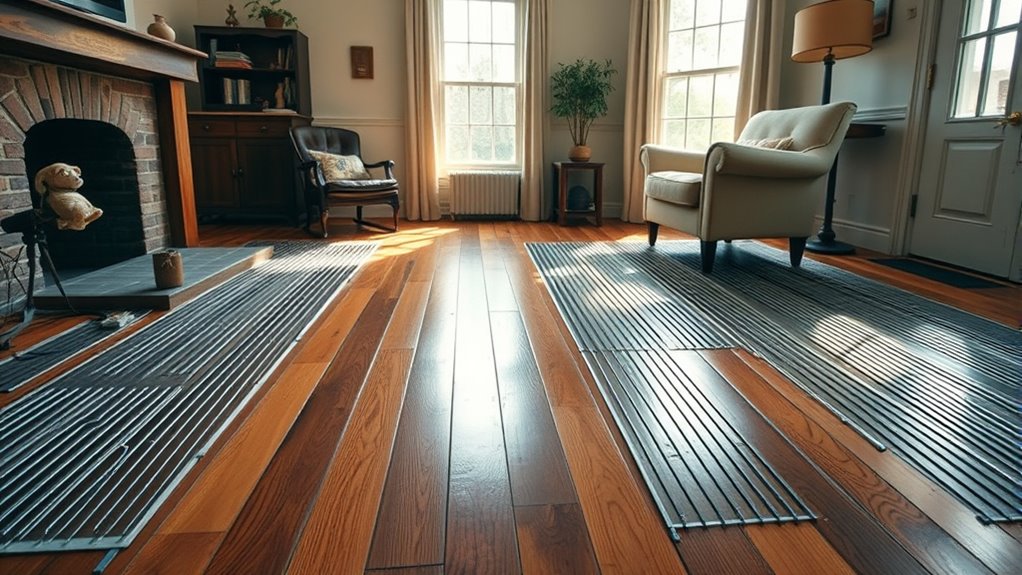
You’ll need to evaluate how accessible the space is for installation, as limited clearance or tight areas can complicate work. Removing existing flooring might be necessary, but it can be difficult or costly depending on the material and condition. Planning for these challenges upfront helps ensure a smoother retrofit process and reduces unexpected delays. Proper insulation beneath tubing or cables is essential to prevent heat loss and maximize system efficiency during the retrofit. Additionally, assessing the signs of spoilage in existing materials can help prevent issues with moisture or mold that might interfere with insulation effectiveness.
Floor Accessibility Concerns
Installing radiant floor systems during retrofits often faces significant accessibility challenges, especially when working from above the existing flooring. Access to the subfloor or joist cavity is limited on upper floors with no basement or crawlspace, making routing difficult. Raising the floor adds height, sometimes over an inch, which can require door adjustments and impact appliances. Obstacles like nails, wiring, and plumbing in joist cavities may block tubing placement and risk damaging utilities if not handled carefully. Modular systems like Uponor’s Quik Trak or SubRay can simplify above-floor installation. Consider the following:
| Access Point | Challenges | Solutions |
|---|---|---|
| From Above | Limited space, obstacles | Modular panels, careful routing |
| From Below | Rare on upper floors | N/A |
| Floor Height | Increased height, clearance issues | Height-adjusting products |
| Utilities | Potential damage | Precise routing and monitoring |
Additionally, understanding the installation process and planning ahead can reduce complications and ensure a successful retrofit.
Existing Floor Removal Difficulties
Removing existing flooring during a retrofit presents a range of structural and logistical challenges that can complicate installation. Old floors often hide fragile joists or framing that risk damage during removal, especially with hidden nails, adhesives, or fasteners. In homes with concrete slabs or thick subfloors, heavy machinery or professional demolition may be necessary, increasing costs and effort. The process generates dust, debris, and noise, requiring protective measures and cleanup that add time. Limited access in crawlspaces or basements complicates tubing routing and securing, and irregular joist spacing can restrict placement. Additionally, existing floor types and materials may be fragile or incompatible with heat, necessitating repairs or modifications. All these factors extend project timelines and raise installation complexity.
Cost Components of Radiant Floor Systems
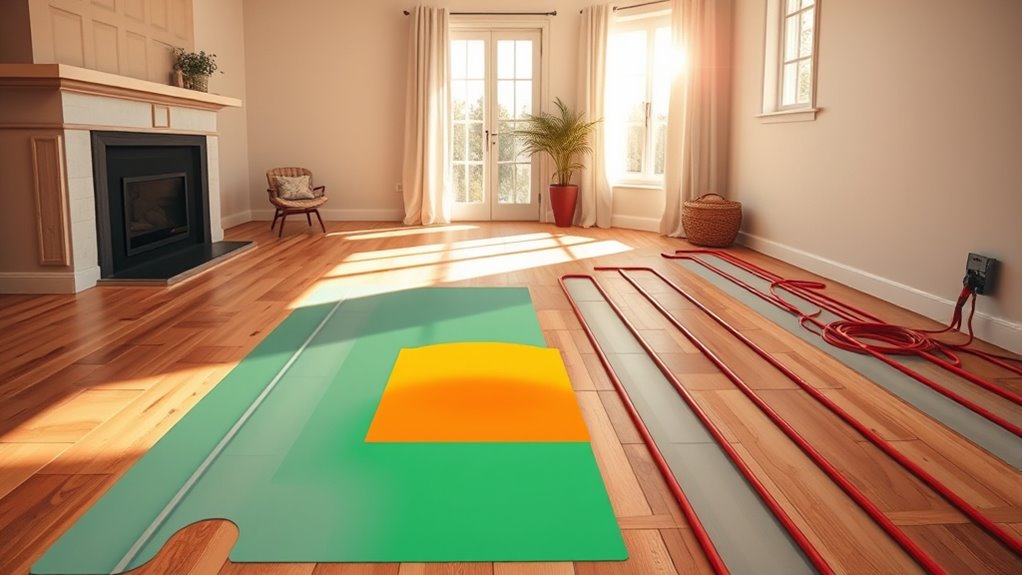
The cost components of radiant floor systems encompass several key elements that influence the overall investment. Material costs primarily include PEX tubing, valued for flexibility and durability, and control units like pumps and control boards, which can cost around $1,250 to $1,300 each. Heat sources such as boilers, water heaters, geothermal pumps, or solar systems vary widely in price. Manifolds, connecting tubing to controls, typically cost $260–$270. Flooring installation adds $4–$15 per square foot, affecting total costs. Labor costs depend on installation complexity, home modifications, and contractor rates, ranging from $7 to $17 per square foot. Whole-house systems can cost between $12,000 and $43,000, scaling with size and system components. These costs can fluctuate based on regional labor rates and material availability, shaping the system’s total expense. Additionally, understanding cookie and privacy policies can help homeowners make informed decisions about data and site functionality during the installation process.
Comparing Electric and Hydronic Heating Options
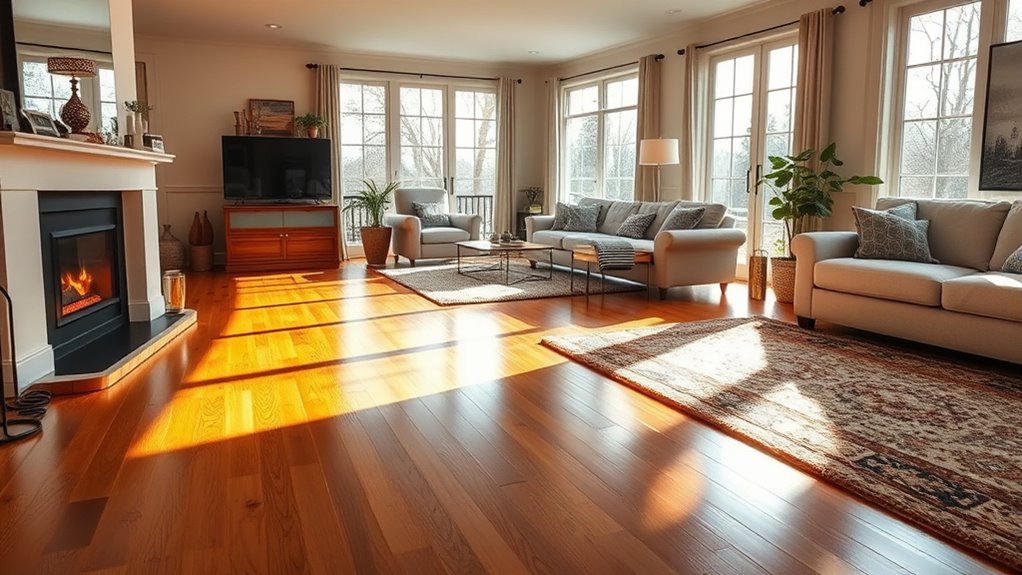
Electric and hydronic radiant floor systems each offer distinct advantages depending on your heating needs and project scope. Electric systems heat up quickly, making them ideal for bathrooms or kitchens where rapid warmth is needed. They’re nearly 99% efficient at converting electricity to heat, and their simple zoning and smart thermostat integration make control straightforward, especially for small areas or retrofits. Electric systems have faster heat-up times, making them suitable for on-demand use in specific rooms or zones. Hydronic systems, on the other hand, provide more efficient, sustained heating, especially in larger spaces. When paired with heat pumps, they can reach about 500% efficiency. While hydronic systems respond slower and require more complex installation, they offer lower operating costs over time, particularly in homes with higher heat demands. Material choices, such as the use of durable and aesthetic wall organization systems, can also influence installation and functionality. Your choice depends on project size, budget, and long-term efficiency goals.
Assessing Flooring Compatibility and Preparation
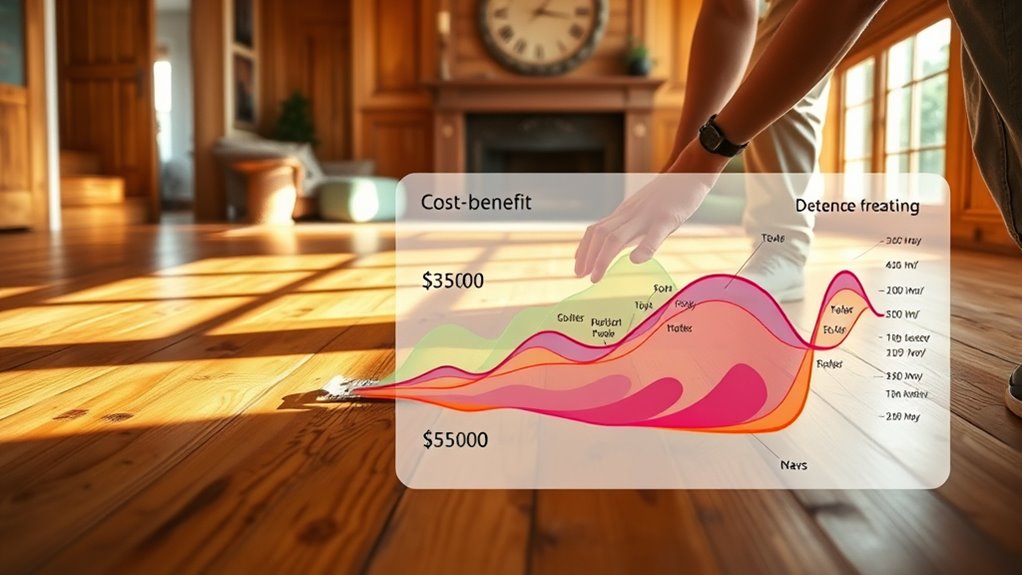
Before installing a radiant floor system, it’s essential to evaluate if your current flooring suits heat transfer needs. Materials like tile, stone, and engineered wood conduct heat efficiently, while carpets and thick vinyl can hinder it. Consider both thermal conductivity and flooring thickness, as thicker materials may require insulation or system adjustments to maintain performance. Durability is also key—your flooring must withstand heat and moisture from the system. Use this table to visualize compatibility:
| Flooring Material | Heat Transfer Efficiency | Thickness Impact | Durability |
|---|---|---|---|
| Tile/Stone | Excellent | Moderate | High |
| Engineered Wood | Good | Thin | Moderate |
| Carpet | Poor | Varies | Low |
| Vinyl | Moderate | Thick | Moderate |
| Laminate | Fair | Moderate | Moderate |
Proper assessment guarantees a successful retrofit with ideal heating. Understanding radiant floor heating’s benefits can help homeowners prioritize suitable flooring options that maximize efficiency and comfort. Additionally, selecting flooring materials with high thermal conductivity can significantly improve heat transfer performance and energy savings.
Operational Efficiency and Long-Term Savings
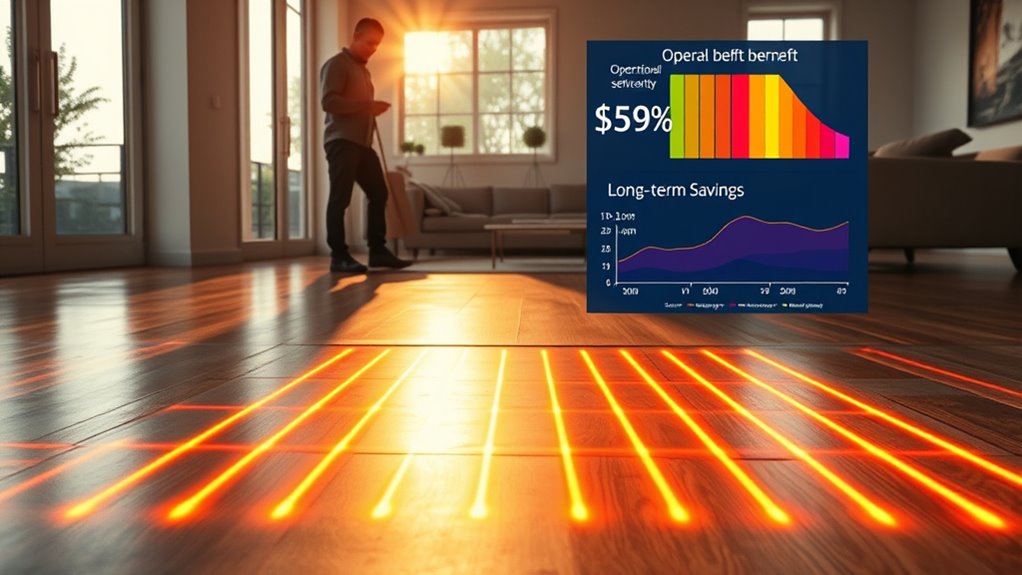
Radiant floor heating systems can deliver impressive operational efficiency by providing even heat distribution and reducing energy waste, especially in well-insulated homes. You benefit from:
- Enhanced Energy Performance: Radiant systems contribute to low- and zero-net energy buildings, with 42% of verified ZNE structures using them. Hydronic systems are particularly effective when integrated with renewable energy sources, further boosting overall efficiency. Additionally, integrating regional flavors and traditions can enhance the comfort and aesthetic appeal of your home’s interior environment.
- Consistent Long-Term Savings: Proper insulation and flooring maximize efficiency, leading to ongoing energy reductions and steady performance.
- Reduced Energy Use: Retrofits can cut energy consumption by a median of 5.9%, with payback periods around 10 years.
- Climate Adaptability: In colder climates, they lower heating needs; in hot climates, radiant barriers reduce cooling loads, optimizing savings year-round.
Identifying Ideal Flooring Materials for Retrofits
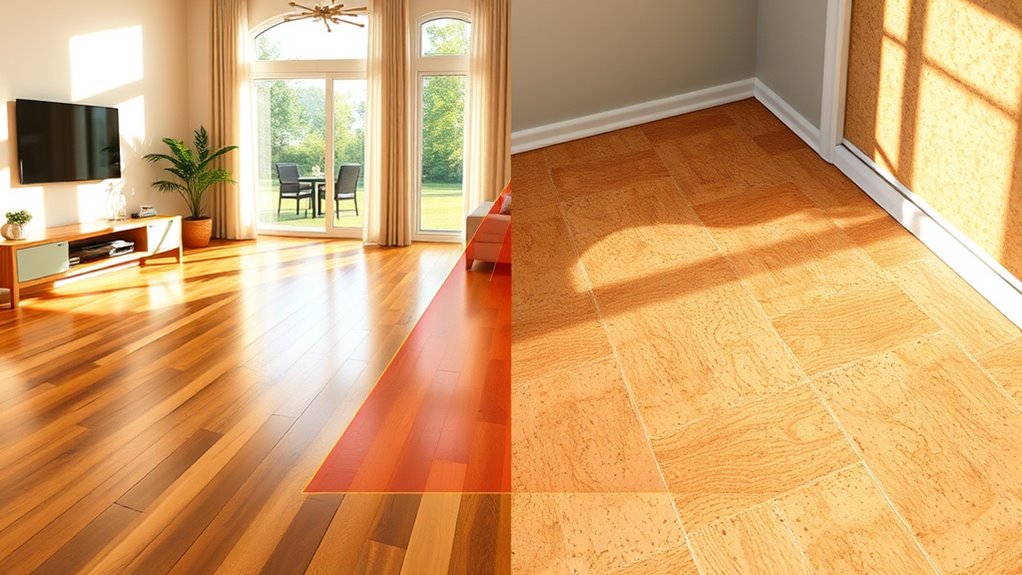
Choosing the right flooring material is essential for maximizing the benefits of a radiant floor retrofit. Porcelain and ceramic tiles are top choices because they transfer heat efficiently, stay stable under temperature changes, and retain warmth longer, boosting energy efficiency. They’re durable, moisture-resistant, and suitable for bathrooms, kitchens, and living areas. Their excellent thermal conductivity makes them particularly well-suited for radiant heating systems. Laminate flooring offers a cost-effective, aesthetic alternative that heats up quickly due to its thin profile, but it’s sensitive to moisture and limited in temperature tolerance. Hardwood provides a classic look but can react to humidity and temperature shifts, risking cracks if not installed carefully. Consider subfloor materials like aluminum-enhanced systems for better thermal conductivity, which improve heat transfer and energy savings. Thermalboard products like Heatply and RHT are designed to enhance heat transfer and insulation, matching flooring with your system and room use ensures ideal performance and longevity.
Making an Informed Decision: Cost-Benefit Analysis
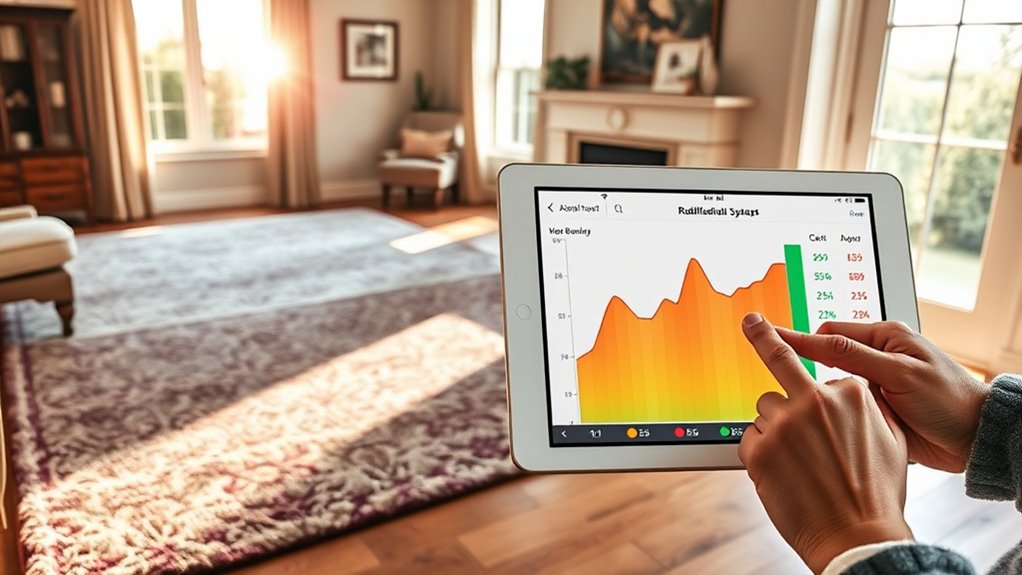
Conducting a thorough cost-benefit analysis helps you determine whether a radiant floor retrofit makes financial sense for your home. Consider these key factors:
- Initial costs vary: Electric systems ($19,000–$36,000), hydronic ($14,000–$48,000), with geothermal and solar options offering different price points. Material costs can significantly influence the overall expense depending on the chosen system. Additionally, the impact of natural materials used in the installation can affect both costs and energy efficiency.
- Long-term savings: Hydronic systems are 20–25% more efficient than forced-air, reducing energy bills, especially in colder climates.
- Installation complexity: Retrofitting may require extra work like flooring removal or subfloor adjustments, increasing costs.
- Maintenance and lifespan: Minimal upkeep and a lifespan of over 35 years add to the system’s value, offsetting higher upfront investments.
Balancing these factors helps you decide if the energy savings and comfort benefits outweigh the installation costs.
Frequently Asked Questions
How Long Does a Typical Radiant Floor Retrofit Project Take?
You’re wondering how long a typical radiant floor retrofit takes. The project duration depends on factors like system complexity, the size of your space, labor availability, and material delivery times. Generally, it can take anywhere from a few days to a couple of weeks. Larger or more complex installations might extend this timeline, especially if inspections or unforeseen issues arise. Planning ahead helps guarantee a smoother, timely process.
What Are the Most Common Unexpected Costs During Installation?
When installing a radiant floor system, you’ll likely face unexpected costs. These include site prep and debris removal, which can add up quickly. You might also need to remove existing flooring, increasing expenses. Hiring specialized labor, like electricians or plumbers, can be pricier than anticipated. Additionally, permits, system compatibility issues, and choosing the wrong materials or insulation can cause unforeseen costs, making the project more expensive than initial estimates.
Can Radiant Floor Heating Be Added to Multi-Story Homes Easily?
Adding radiant floor heating to multi-story homes isn’t a walk in the park, like trying to find the Holy Grail. You face challenges with limited access, especially on upper floors, and the need to lift existing flooring. Installation involves significant labor, potential floor removal, and careful zoning. While it’s doable, expect disruptions and higher costs, making it less ‘easy’ compared to single-story retrofits.
How Does Retrofitting Impact Existing Home Resale Value?
Retrofitting your home with radiant floor heating can considerably boost its resale value. It’s a desirable feature that appeals to buyers seeking energy efficiency and luxury. Plus, it can help your home stand out in a competitive market. You’ll likely see a higher selling price and quicker sales, as heated floors are considered a premium upgrade. Overall, investing in retrofitting can pay off when you decide to sell.
Are There Financing Options or Incentives Available for These Upgrades?
You’re wondering about financing options and incentives for home upgrades. While radiant floor heating itself doesn’t usually qualify for direct federal rebates, you can benefit from incentives for related improvements like insulation or electrical upgrades. Plus, there are financing options such as energy-efficient loans, home equity loans, or PACE programs that can help cover retrofit costs. Check your local programs and utility rebates, as these can offer additional support.
Conclusion
While radiant floor retrofits can be a lovely upgrade, they might not always be the easiest or most cost-effective choice for every home. Carefully weigh the benefits against installation challenges and long-term savings to see if it’s truly the right fit. Sometimes, exploring alternative heating options can bring just as much comfort without the extra fuss. Ultimately, making an informed decision guarantees you enjoy cozy warmth without any unintended surprises down the line.
I’m Theodore, and I love tiny houses. In fact, I’m the author of Tiny House 43, a book about tiny houses that are also tree houses. I think they’re magical places where imaginations can run wild and adventures are just waiting to happen.
While tree houses are often associated with childhood, they can be the perfect adult retreat. They offer a cozy space to relax and unwind, surrounded by nature. And since they’re typically built on stilts or raised platforms, they offer stunning views that traditional homes simply can’t match.
If you’re looking for a unique and romantic getaway, a tree house tiny house might just be the perfect option.
